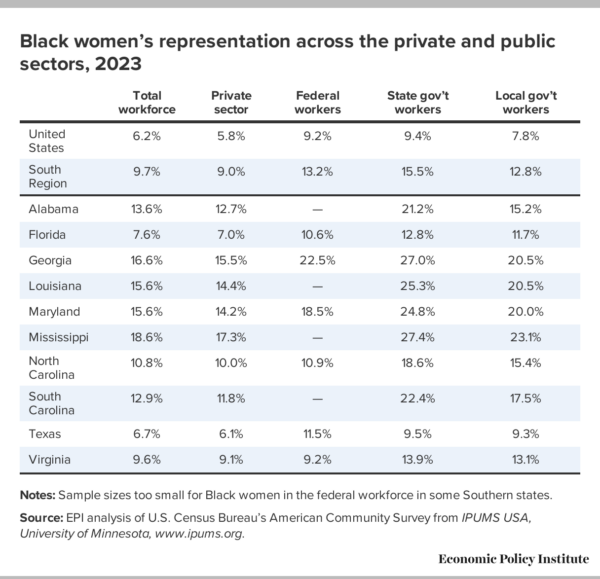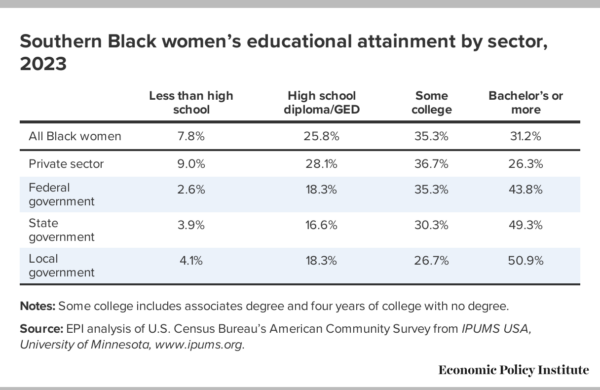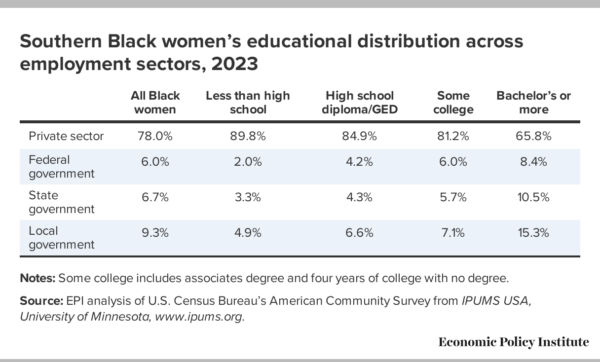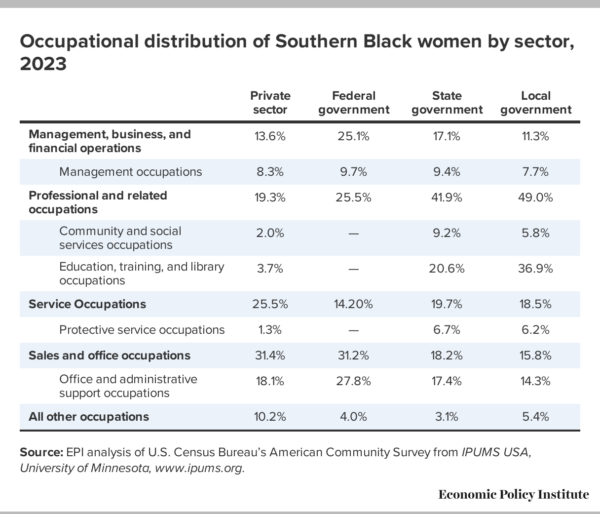In many states across the South, the public sector is a key driver of economic growth and improvements in most Southerners’ quality of life. The public sector includes workers in federal, state, and local government that we all rely on to educate children across the region, care for sick and elderly family members, ensure food and water are safe to consume, provide public transportation and sanitation services, and ensure access to a wide range of other public services.
Unfortunately, many in the U.S. fail to recognize how central the public sector is to their daily quality of life. Further, these workers and the public sector generally are often maligned by lawmakers seeking to undermine public agencies and the workers that staff them. This facilitates disinvestment in the public sector. Over the last few decades, public-sector wages have failed to keep up with the cost of living, retirement benefits have been cut, and workloads have steadily increased as workers have left or been pushed out of these jobs. These declines in public-sector job quality across the South have led to higher turnover rates, understaffed agencies, and a decline in the quality of public services.
The decline in public-sector job quality across the South disproportionately harms Black workers, especially Black women, their families, and communities. Black workers have historically faced widespread racial discrimination in the private sector in hiring, job assignment, and pay. The situation was even worse for Black women who faced sexism in addition to racism. This often meant Black women were limited to the most menial jobs, most commonly finding work as domestic workers in private households and as agricultural laborers.
Legislative and executive actions taken in the 1960s and 1970s made the public sector—especially at the federal level—a crucial source of employment opportunities for Black workers. Today, the public sector continues to provide significant economic opportunities for Black women.
Table 1 shows that both nationally and across the South, Black women are disproportionately represented among public-sector workers compared with their share of the total workforce. This disproportionate representation is greatest across the South: Black women are 9.7% of the total workforce and 9.0% of the private sector but make up 13.2% of federal, 15.5% of state, and 12.8% of local government workers.

Table 1 shows Black women’s representation across those Southern states with adequate sample sizes. Black women make up more than one in five local government workers and more than one in four state government workers in Mississippi, Georgia, Louisiana, and Maryland. They also make up 22.5% of the federal workforce in Georgia, 18.5% in Maryland, and 11.5% in Texas.
The most highly educated Southern Black women work in the public sector
These Black women are some of the most highly skilled and educated Black women in the workforce. Table 2a shows the educational attainment of Southern Black women by sector. Overall, just 7.8% of Southern Black women have less than a high school diploma, just over one in four have only a high school diploma, while roughly one in three have either some college education (35.3%) or a bachelor’s degree or more (31.2%.) Among Southern Black women working in the public sector, 43.8% of those in federal government and roughly half working in state (49.3%) and local (50.9%) government have at least a bachelor’s degree compared with just 26.3% of those in the private sector.

Table 2b shows how Southern black women at each level of education are distributed across employment sectors. As Black women’s educational attainment increases, so does their representation in the public sector. For example, 78% of all Southern Black women work in the private sector but among those with less than a high school diploma, 89.8% are in the private sector.

Conversely, among Southern Black women with a bachelor’s degree or more, just 65.8% work in the private sector. In fact, Black women across the South with a bachelor’s degree or more are at least twice as likely as Southern Black women with only a high school diploma to work in federal (8.4% vs. 4.2%), state (10.5% vs. 4.3%), and local (15.3% vs. 6.6%) government.
Southern Black women in the public sector disproportionately serve the public as managers, educators, and professionals
Black women in the public sector disproportionately fill jobs in “management, business, and financial operations” (management) and “professional and related occupations” (professional).
Table 3 shows Black women’s occupational distribution across broad occupational groups by sector. The single largest occupational group for Black women in the private sector is sales and office occupations (31.4%), followed by service occupations (25.5%), and then professional and related occupations (19.3%).

In the federal workforce, Black women are also disproportionately employed in “sales and office occupations” (31.2%). Most women in these jobs work in office occupations but a small percentage work as supervisors of sales workers, cashiers, retail salespersons, and other sales and related jobs. However, more than half of Black women in the federal workforce are employed in management (25.1%) and professional (25.5%) occupations. In state and local government, more Black women work in professional occupations (41.9% and 49.0%) than any other profession. Table 3 shows they work predominantly in education and in community and social service jobs—jobs that provide critical direct services to the public.
Public-sector cuts hurt everyone
Efforts by the Trump administration and congress to cut the federal workforce, cut funding to states, and ongoing state-level efforts to cut public services and attack public-sector workers will harm the Black women who hold many of these jobs. Many of the state and local public-sector workers who have been pushed out by declining job quality and the more than 260,000 federal workers estimated to have either been fired, taken a buyout, or to have retired are facing increasing economic hardship as they are faced with a labor market with declining prospects.
The impacts of public-sector job cuts are not limited to the workers themselves but can cause potentially irreparable harm to communities across the nation. At the most basic level, the rapid rise in unemployed workers can cause ripples through local labor markets as the ability of these workers to patronize private-sector businesses falls.
Workforce cuts across the public sector will also mean fewer workers available to administer basic services such as social security benefits or to address the concerns of social security recipients facing longer wait times. It means declining care for veterans and for geriatric and autistic patients. It means a lack of disaster preparation. And it could mean the loss of federal child care centers and other supports that families rely on.
While the contributions of public-sector workers are often overlooked, their absence will certainly be felt by all of us.


